Discover the answer to the common question, “How long after giving birth can I start wearing a support belt?” Learn about the benefits of postpartum support belts and find out when it is safe to start using one for optimal comfort and recovery after childbirth..
How Long After Giving Birth Can I Start Wearing a Support Belt?
Congratulations on your new bundle of joy! Now that you have embarked on the incredible journey of motherhood, you might be curious about all the helpful tools and accessories available to support you during this post-pregnancy period. One such item that many new moms consider is a support belt. These magical contraptions may seem like a superhero’s secret weapon, but when should you slip into one of these wonder belts? Let’s find out!

Understanding the Purpose of a Support Belt Post-Pregnancy
Before we dive into the timing, let’s take a moment to understand why support belts are a thing in the first place. Support belts are like your very own support squad, providing gentle compression to your abdomen and lower back. Their reliability lies in their ability to bring stability to these areas, which can be a bit wobbly after childbirth. They’re like your trusty sidekick, offering that extra helping hand during your postpartum recovery.
But what exactly does it mean for a support belt to provide gentle compression? Well, imagine a warm embrace around your midsection, gently hugging your body and giving it the support it needs. This compression not only helps to bring stability to your abdomen and lower back, but it also helps to alleviate any discomfort you may be experiencing in these areas. It’s like having a personal masseuse, working to soothe and relax your muscles.
Now, let’s talk about the role of support belts in postpartum recovery. Postpartum recovery is a marathon, not a sprint. It’s a time of healing and adjustment, both physically and emotionally. Support belts play a vital role by providing much-needed comfort and support to your healing body. They can help to alleviate the strain on your pelvic muscles and ligaments, easing any discomfort you may be experiencing. Think of it as having a little helper to keep everything in place while you navigate the joys and challenges of new motherhood.
The Role of Support Belts in Postpartum Recovery
Postpartum recovery is a journey, and support belts are your trusted companions along the way. As your body adjusts to its new normal, support belts can provide the stability and support you need to feel confident and comfortable. They act as a gentle reminder to take care of yourself, both physically and emotionally.
But how exactly do support belts help with postpartum recovery? Well, let’s break it down. After childbirth, your body goes through a lot of changes. Your abdominal muscles may be weakened, and your lower back may feel achy and unstable. This is where support belts come in. By providing gentle compression to your abdomen and lower back, they help to bring stability to these areas, allowing your muscles to heal and recover.
But it’s not just about physical support. Support belts can also have a positive impact on your mental well-being. As a new mother, it’s common to feel overwhelmed and unsure of yourself. Wearing a support belt can give you a sense of security and confidence, knowing that you have that extra layer of support as you navigate the ups and downs of motherhood.
Health Benefits of Wearing a Support Belt
Wearing a support belt can bring you a treasure trove of health benefits. Firstly, it can lend a helping hand in improving your posture. We all know how easy it is to develop a slightly hunched stance while juggling baby duties. The weight of your baby, coupled with the strain on your abdominal muscles, can cause your posture to suffer. But fear not, because support belts are here to save the day. By providing gentle compression to your abdomen and lower back, they help to align your spine and encourage proper posture.
Secondly, these belts can provide gentle compression, which may increase blood circulation and reduce swelling in the postpartum belly. After giving birth, it’s common for your abdomen to feel swollen and tender. This swelling is a natural part of the healing process, but it can also be uncomfortable. Support belts can help to alleviate this discomfort by promoting better blood flow and reducing swelling.
Lastly, wearing a support belt can also provide a sense of comfort and security. As a new mother, it’s normal to feel a bit vulnerable and unsure of your body. Wearing a support belt can give you that extra layer of support, both physically and emotionally. It’s like having a trusted friend by your side, reminding you that you’re not alone in this journey.
Factors Influencing the Timing of Wearing a Support Belt
Now, let’s get to the heart of the matter and unravel the factors that influence when you can rock your support belt like a fashionista mama.
When it comes to postpartum recovery, there are several factors to consider before strapping on that support belt. These factors can vary from woman to woman, depending on their unique circumstances and individual health conditions.
Type of Delivery and Its Impact
Whether you experienced a vaginal birth or embraced the magical world of Caesarean sections, the type of delivery you had can have an impact on when you can start wearing a support belt. Vaginal birth warriors often find themselves ready to embrace the support belt right away, as their bodies have undergone the natural process of childbirth. The support belt can provide much-needed relief and support to the abdominal muscles that have been stretched during labor.
On the other hand, C-section mamas may need to wait a little longer for those surgical incisions to heal before using a support belt. The incisions made during a C-section require time to close and heal properly. It’s important to follow your healthcare provider’s guidance and wait until you have received the green light to start using a support belt. Remember, every body is unique, so listen to yours and consult with your healthcare provider for personalized advice.
Individual Health Conditions and Recovery Rate
Another critical factor to consider is your individual health conditions and recovery rate. Each mama’s recovery journey is as unique as a fingerprint. Some may rapidly bounce back like a resilient rubber ball, feeling ready to conquer the world in no time. These mamas may be able to start wearing a support belt sooner, as their bodies respond well to the postpartum healing process.
However, for others, the recovery process may take a little more time and tender loving care. Factors such as pre-existing health conditions, complications during childbirth, or a slower recovery rate can influence when it’s appropriate to start using a support belt. It’s important to be patient with yourself and allow your body the time it needs to heal and regain strength.
Despite the urge to don your support belt at the earliest opportunity, it’s crucial to let your body dictate the pace of your postpartum recovery. Pushing yourself too soon can potentially hinder the healing process and lead to further complications. Always consult with your healthcare provider to ensure you are making the right decision for your individual circumstances.
Guidelines for Wearing a Support Belt After Childbirth
Now that we’ve explored the influencing factors, let’s move on to some handy guidelines about wearing a support belt after childbirth.
After giving birth, your body goes through a series of changes as it adjusts to its new postpartum state. One of the common challenges many new mothers face is the weakened abdominal muscles and the strain on the lower back. This is where a support belt can come to the rescue, providing much-needed support and stability.
When to Start Using a Support Belt
The million-dollar question! While we can’t give you an exact date and time, as much as we’d like to be fortune-telling wizards, a general rule of thumb is to wait until your uterus has returned to its pre-pregnancy size. This usually takes around six to eight weeks. But remember, the key here is to listen to your body.
During the first few weeks after childbirth, your body is still healing, and it’s essential to give it the time it needs to recover. Pay attention to any discomfort or pain you may be experiencing. If you still feel unsure, consult with your healthcare provider, who can guide you on the best time to dive into your support belt adventure.
How Long Should You Wear a Support Belt
Ah, the timing continues to be a puzzle! The duration of support belt usage may vary from one mama to another. Some may find comfort in wearing it for a few weeks, while others may choose to embrace its support for a more extended period.
As you gradually regain your strength and your body starts to feel more resilient, you may find that the need for a support belt diminishes. It’s crucial to pay attention to your body’s signals and let them be your guide. Once you feel like you can conquer the world without the help of your trusty belt, you may have reached the finish line of your support belt journey.
However, it’s worth noting that some women may continue to wear a support belt even after their bodies have fully recovered. This could be due to personal preference or if they engage in activities that put additional strain on their abdominal muscles, such as heavy lifting or prolonged standing.
Ultimately, the decision of how long to wear a support belt is a personal one. It’s essential to listen to your body, consult with your healthcare provider, and make an informed choice that best suits your individual needs and circumstances.
Potential Risks and Precautions
As with any superpowers, there are some potential risks and precautions to be aware of when using a support belt.
Possible Side Effects of Wearing a Support Belt
While support belts can be a valuable aid, it’s essential not to rely on them as a permanent crutch. Prolonged usage without giving your core muscles some time to shine independently may weaken them over time. So, think of your support belt as a trusty sidekick rather than a lifelong partner.
Safety Measures While Using a Support Belt
Mindfulness is key here. Be sure to follow the manufacturer’s instructions on how to wear and care for your support belt. Additionally, it’s crucial not to tighten the belt excessively, as this can restrict your blood flow and cause discomfort. Embrace your newfound power responsibly!
Consulting with Healthcare Professionals
We’re almost at the finish line, but there’s one vital part left to explore – consulting with the wise masters of the healthcare realm.

Importance of Doctor’s Advice
Your healthcare provider is your ultimate guide on this postpartum journey. They know the ins and outs of your unique situation and can provide personalized advice based on their expertise. Be sure to share your support belt aspirations with them, and let them steer you in the right direction.
Role of Physical Therapists in Postpartum Recovery
Physical therapists are the unsung heroes of the postpartum realm. They possess a wealth of knowledge on postpartum rehabilitation and can guide you on exercises and techniques that can complement your support belt usage. Reach out to these magical beings and harness their wisdom to make your recovery journey even more spa-like!
In conclusion, the timing of when to start wearing a support belt after giving birth is as individual as the lullabies you sing to your little one. Remember to honor your body’s needs and consult with healthcare professionals to ensure you embrace the incredible benefits of support belts while staying safe and healthy. So, mama, when you’re ready, slip into that support belt and conquer the world – one superhero-worthy step at a time!



